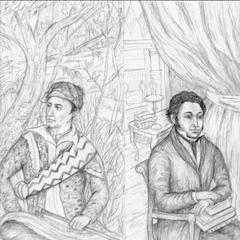|
J. William T. "Bill" Youngs, American Realities, Volume One:
Historical Episodes from First Settlements to the Civil War, Chapter Eleven |
Fall of the Alamo, courtesy of the Texas State University
|
11. The Texas Revolution
|
Summary
The American frontier — with its promise of inexpensive land and the opportunity to get ahead — attracted thousands of settlers during the early nineteenth century. Although initially a Mexican state, Texas became a favorite destination of many of these settlers. In 1835 Texans would revolt against Mexican rule and establish a separate country, modeled on the United States. The revolt was in some respects a movement of Americans intent on wresting Texas from Mexico and turning it over to the United States. But the Texas Revolution also had roots deep in Mexican history, and one of its leaders had been one of the foremost reformers in Mexico itself during that country’s early years of independence. The careers of Lorenzo de Zavala and Sam Houston epitomize the blending of American and Mexican sources in the history of revolutionary Texas.
|
Author reads from the Text
The two armies were camped near each other on the night of April 20. Santa Anna slept comfortably in a tent, while Sam Houston slept on the ground with a coil of rope as a pillow. The next morning Santa Anna’s force was swelled by the arrival of 550 additional troops. That gave him 1,350 soldiers compared to Houston’s 900. Confident of victory the dictator invited the newcomers to eat and rest in the early afternoon, not even posting guards by his camp. In the American camp, the soldiers prepared themselves for battle. A troop of Tejanos, native-born Mexicans from San Antonio de Béxar, placed slips of paper in their hats with the slogan, recuerdo el Alamo, remember the Alamo, to distinguish them from Santa Anna’s troops.
In the mid-afternoon Houston’s men faded into the tall grass separating them from Santa Anna’s camp. Suddenly, they appeared among the Mexicans, firing their rifles and shouting, “Remember the Alamo!” Houston was hit in the ankle with a bullet, but fought on. In just eighteen minutes the battle was over. Six hundred of the enemy were killed, another six hundred captured. The Texans lost only nine men in the Battle of San Jacinto. Santa Anna hid near the camp, but was captured the next day. He surrendered to Houston, who was lying propped up against a tree, unable to walk because of his shattered ankle.
A few days later Lorenzo de Zavala visited the battlefield and met with Santa Anna. Unfortunately, we have no record of what the old adversaries said to each other. But we do know that Zavala favored humane treatment for the fallen dictator. Many Texans wanted him killed in revenge for the Alamo and Goliad, but Houston, Zavala, and others prevailed in allowing Santa Anna to live. Santa Anna negotiated two agreements with the Texans, recognizing their independence.
In the mid-afternoon Houston’s men faded into the tall grass separating them from Santa Anna’s camp. Suddenly, they appeared among the Mexicans, firing their rifles and shouting, “Remember the Alamo!” Houston was hit in the ankle with a bullet, but fought on. In just eighteen minutes the battle was over. Six hundred of the enemy were killed, another six hundred captured. The Texans lost only nine men in the Battle of San Jacinto. Santa Anna hid near the camp, but was captured the next day. He surrendered to Houston, who was lying propped up against a tree, unable to walk because of his shattered ankle.
A few days later Lorenzo de Zavala visited the battlefield and met with Santa Anna. Unfortunately, we have no record of what the old adversaries said to each other. But we do know that Zavala favored humane treatment for the fallen dictator. Many Texans wanted him killed in revenge for the Alamo and Goliad, but Houston, Zavala, and others prevailed in allowing Santa Anna to live. Santa Anna negotiated two agreements with the Texans, recognizing their independence.
Texas Revolution
View American Realities: Texas Revolution in a larger map

